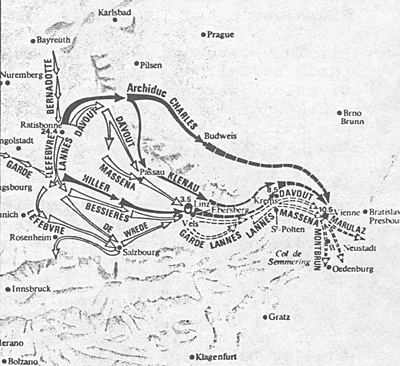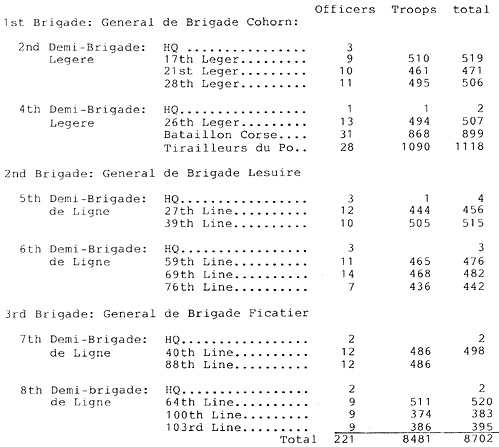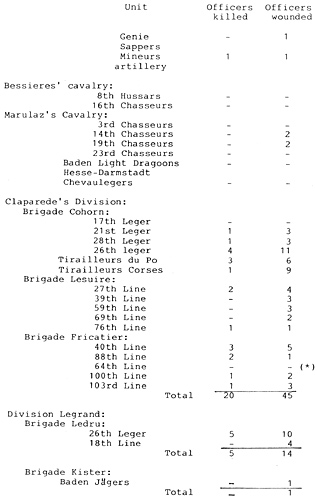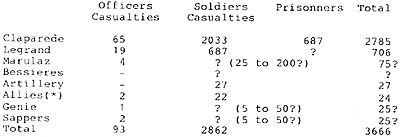 A new look at the French casualties at the combat of Ebelsberg during the Campaign of 1809 against Austria has been motivated by Mr. Glasnovich'S request published in our last issue. In EEL 77, pages 23 and 54, Mr. Joseph Glasnovich presented his comments and questions on battle casualties (Marengo, Wagram, etc.) in general and specifically on the French losses at Wagram and Ebelsberg. The questions have beei reformulated and the texts are to be found in our "QUESTIONS AND ANSWERS" section of this issue.
A new look at the French casualties at the combat of Ebelsberg during the Campaign of 1809 against Austria has been motivated by Mr. Glasnovich'S request published in our last issue. In EEL 77, pages 23 and 54, Mr. Joseph Glasnovich presented his comments and questions on battle casualties (Marengo, Wagram, etc.) in general and specifically on the French losses at Wagram and Ebelsberg. The questions have beei reformulated and the texts are to be found in our "QUESTIONS AND ANSWERS" section of this issue.
1.0 The Combat at Ebelsberg
The combat of Ebelsberg (also sometimes refered, wrongly, as Ebersberg in some French accounts) took place after the battles of Abensberg and Eckmdhl, when the Austrian army fell back on Vienna, their retreat covered by General Hiller's VI Corps. According to David Chandler's "Dictionary of the Napoleonic Wars", (MacMillan Publishing Co. New York, 1979) p. 135:
- "At the river Traun he (Hiller) turned at bay, determined to win time for the capital's defense, massing 40,000 men and 70 guns. After a preliminary action at Wels on the 2nd, Massena launched a strong frontal attack across the river Traun.... After a costly storming of the bridge at 10 AM, Claparede's Division entered the town, but the Austrians remained in possession of the castle and its height, while beyond it was the ridge where Hiller had deployed his main forces. Claparede was soon fighting for survival, but at midday Massena was able to send part of the newly arrived LeGrand's Division into the town, and after a bitter fight the 26th Regiment stormed the castle as the 18th and some Baden troops cleared the town. Miller, surprisingly, did not counterattack, although the French never fielded more than 22,100 men. their losses were 2,800 men (Claparede alone losing 2,100 or 257 of his Division), while Hiller lost an estimated 2,000 killed and perhaps 4,000 taken prisoner Napoleon criticized Massena for making such a risky attack." (see Notes 1 and 2)
A more detailed account of the combat of Ebelsberg is given, in this issue, in our "WAR OF 1809" section.
2.0 Allied and French Troops Engaged at Ebelsberg
Massena received the command of the IVth Corps sometimes if February 1809, much before the beginning of the Campaign. The IVth Corps was formed around 4 veteran infantry Divisions (Legrand, Carra-St-Cyr, Molitor and Boudet) and of Marulaz's Cavalry Division, which included the Regiment of Baden Light Dragoons and the Regiment of Hesse-Darmstadt Chevaulegers. Legrand's Division included a brigade of Baden infantry (some 7 battalions, 5494 men) and some Baden artillery. Carra-St.Cyr's Division included a Hesse-Darmstadt infantry brigade (6 battalions, 4172 men).
An order to Massena, dated 15 April, 1809, (i.e. at the beginning of the Campaign of 1809), placed Oudinot's IInd Corps (known as "Oudinot's Grenadiers Corps") under his control. Oudinot's Corps to pursuit the retreating Austrian Army, was broken down in several tactical groups, by divisions and mixed them with the more experienced troops of his IVTH Corps.
Claparede's Division and Marulaz's cavalry Division were the vanguard of Massena's troops pushing toward Ebelsberg. Legrand's Division was about 3 hours behind them.
In EEL 52, pp.25 to 31, the organization and strength of Oudinot's Grenadiers during the Campaign of 1809 was investigated in depth from basic data traceable to official French Archives. Oudinot's Grenadiers included, on April 15th, 1809, two infantry divisions Claparede, object of our inquiry, and Tharreau, beside, of course, artillery and cavalry.
There are some very important points about Oudinot's Grenadiers Claparede's and Tharreau's Divisions:
(1) They were not elite formations, with the exception of the two ve teran battalions "Tirailleurs du Po" and "Tirailleurs Corses". Both Divisions were included newly raised 4th battalions, formed around a nucleus of grenadiers and voltigeurs companies from the old Oudinot's Grenadiers (see EEL 52) with primarily half-trained or untrained raw conscripts.
(2) All the 4th battalions had only 4 companies, one of grenadiers, one of voltigeurs and two of fusiliers. The Tirailleurs du Po and the Tirailleurs Corses had kept the old 9 companies organization. The 4th battalions were reorganized on the 6 company pattern for the battle of Wagram.
Which units were involved in the battle of Ebelsberg? Tt is difficult to be 100% sure. We were surprised to find in Martinien that some units, not mentioned by Massena and other sources, were involved like the 4th battalion of the 18th of the Line part of Tharreau's division (Jarry's brigade). They may be other units, but if officer casualties were not recorded they would not be mentioned by Martinien. In addition, sappers of the 2nd battalion de Sapeurs , genie and artillery also took part in the action. Each of these units to be seen as we take a look at the casualties.
Allied and French Casualties at Ebelsberg
Firstly we have to point that French reliable (but not limited to the a French!) data casualties is scarce, often uncomplete or unreliable, and, at times, simply non-existent. We did not find any one, single, French source giving a complete set of casualty figures for all the units involved (We are not even sure about all the units involved at Ebelsberg!). That is not unusual, and one must gather figures from several sources to get an approximately complete picture of the losses. A time consuming task, which we would not have been able to perform without my wife patient and efficient search for pertinent data at the Princeton University Library.
Some French sources, like Pelet's Memoires sur la Guerre de 1809 en Allemagne", underestimate the French losses:
"Our losses were 4 to 500 killed and the double of wounded".
Secondly, Mr. Glasnovich's questions appears to imply that the difference of 5450, unaccounted for, may be Ebelsberg casualties. , think that is wrong because Claparede's Division: (1) was involved in other combats between 15th April and 21-22 May, 1809 and (2) does not take in consideration the so-called strategic consumption or attrition, especially high with conscripts that were at least 50% of the effectives of Claparede's Division, with the exception of the Corsican Tirailleurs and Tirailleurs du Po battalions; and (3) that reenforcements may have been received before the 22nd of May.
A quick look at Petre's "Napoleon and the Archduke Charles, Gachot's "Napoleon en Allemagne, (1809)" and Martinien's "Tableaux par Corps et par Batailles des Officiers Tues ou Blesses Pendant les Guerres de 1'Empire (1805-1815) shows that Claparede's Division was involved in several encounters between 15 April and the estimated returns of 22 May, too numerous to be ignored. Some of them are:
- (1) A skirmish at Mainburg on 19 April, Petre, pp.125-6 says: "At 4 AM, Oudinot fell upon Schaibler's little force with Colbert's light cavalry and Clararede's Division... The affair was a petty one with loss of about 100 on either side..." Obviously, it's hard to distribute the about "100 casualties" among Colbert and/or Claperede.
(2) At Landshut in which Marulaz and Cohorn (a Brigadier of Calparede) are involved costing a few wounded according to Massera's report of 21 April.
(3) A skirmish at Eckmuhl, on the 22nd, in which the Chef de Bataillon Baudinot, commanding the 4th battalion of the 26th Leger was wounded. (ref. Martinien)
(4) At Linz.
(5) Combat of Ertingen (29 April, 1809) in which two officers of the Tirailleurs du Po were wounded (Ref. Martinien).
(6) Combat of Ried (1 May, 1809): Tirailleurs du Po, one officer killed (Captain Pagliani) (ref. Martinien).
(7) Battle of Thann: (19 April, 1809) 18th Leger, one officer wounded (ref. Martinien)
(8) Combat in front of Vienna (9 May, 1809): Tirailleurs Corses, officers wounded (ref. Martinien).
We are sure the above list is far to be exhaustive. How many casualties were suffered by Claperede's Division in such actions? Martinien only reports officers casualties, so, without extensive work, (perhaps a month or so in the French Archives!) it is impossible for us to quantify them. However, we know they casualties were inflicted in these actions. To be complete, we had to bring that very pertinent point out.
(1) April 15th Returns for Claperede's Division
The figures provided by "Armies On The Danube", pp.56-7, are in agreement with the other returns traceable to French official archives documents I have available and which I report below:
2nd Infantry Division: General de Division Claparede

The total figure of 8702 men is slightly under the figure of 10195 men given in the above question. "Armies On the Danube" total are also 8702 men.
Note: The returns for Tharreau's Division part of the same Corps are for the infantry only: 184 officers and 6785 men (Total 6969 men), which is also in agreement with "Armies On The Danube".
(2) Claperede Effectives as per-the Returns Of 21-22 May, 1809"
(Source "Armies On The Danube", p.85)
The returns are on page 85 of "Armies On The Danube":
2` CORPS D'ARMEE
Marechal Lannes, Duc de Montebello
Etat-major: General de Brigade Gauthier
ADVANCE GUARD-General de Division Oudinot; strength returns for Oudinot's divisions immediately prior to Aspern-Essling to not exist. Therefore these strengths are approximate.
1st DIVISION-General de Division Tharreau
- Brigade Conroux -6th, 24th, 25th, 9th, 16th and
27th Legere, 4th battalions
only (6) @2,500
Brigade Albert -8th, 24th, 45th, 94th, 95th and 96th Ligne. 4th battalions only (6) @2,600
Brigade Jarry -4th, 18th, 54th, & 63rd Ligne, 4th battalions only (4) @1,800
One 8 pdr. company a pied. consisting of four 8 pdr. guns and two 6 p. howitzers. One 4 pdr. company a cheval, consisting of six 4 pdr. guns.
2nd DIVISION-General de Division Claparede
- Brigade Coehorn
17th, 21st. 26th. and 28th Legere, 4th battalions only (4) @ 1,300
Tirailleurs du Po 11) @ 450
Tirailleurs corses (1) @ 450
Brigade Lesuire 27th, 39th. 59th, 69th, and 76th Ligne. 4th batalions only (5) @ 1700
Brigade Ficatier 40th, 88th, 64th, 100th and 103rd Ligne. 4th battalions only (5) @ 1550
One 8 pdr. company a pied, consisting of four 8 pdr. guns and two 24 p. howitzers. One 4 pdr. company a cheval, consisting of four 4 pdr. guns and two 6 p. howitzers.
We have a total of:
(1) Claperede's Division: 5450 men
(2) Tharreau's Division : 6900 men
It's important to note that, since the official returns do not exist, the figures provided are only approximate, a fact that is acknowledged in the text.
The difference between the returns of 16th April and the (approximate) returns of 21-22 May are:
Claparede's Division: 8702 - 5450 = 3250 men
Tharreau's Division : 6969 - 6900 = 96 men
which we may consider, although approximate, as unaccounted for and may or may not be the losses at Ebelsberg and/or that of the campaign from 16th April to 22 May, 1809.
(3) Losses At Ebelsberg
As Per Some French Sources":
Beside Pelet, we have an unusual large amount of sources on casualties at Ebelsberg. One commonly available source Petre (in "Napoleon and the ArchDuke Charles") p. 242, gives an assessment of French losses:
- He had not the excuse of inferior troops, for Massena justly says that the "enemy defended himself like a lion." That is true of the Austrian soldiery, but what could they do when they were so miserably handled by their commanders? The losses were naturally very heavy, though it is, as usual, difficult to say precisely what they were. French returns are often missing, and when they are given they are not often very reliable. Legrand alone gives his killed and wounded at 70 t, out of the 4000 French who were almost all that he engaged. The Baden brigade only lost 23 men. Massbna says he lost altogether 2800, of whom 188o were killed. The proportion of killed to wounded is incredible. Even at that rate, Claparede must have lost 2100 (2800 - loo Legrand) out of 8400-25 per cent. of his whole force. The Austrians give their loss at about 2000 killed and wounded, 2200 prisoners. Masstna estimated his prisoners at 7000 or 8000. Probably the actual numbers were intermediate between these figures. [Napoleon next day, writing to Lanues, put it at 4000] Massena also says he took 2 guns and 2 flags, of which the Austrians make no mention. [Vide supra, p. 232.]
 Petre, (and we guessed) got his figures from "Memoires d'Andre Massena " published by General Koch, from Massena's notes, in 1848. Since Massena's Memoires were available we took a look at them and found, included among their sources, a copy of the battle reports from Claparede, Legrand, etc., which gave their losses at Ebelsberg:
Petre, (and we guessed) got his figures from "Memoires d'Andre Massena " published by General Koch, from Massena's notes, in 1848. Since Massena's Memoires were available we took a look at them and found, included among their sources, a copy of the battle reports from Claparede, Legrand, etc., which gave their losses at Ebelsberg:
- (*) Legrand's report reproduced below (in French, see note 3) says 30, but the total given by Legrand reflects only 3 wounded officers. Martinien's figure is 4 officers wounded.
(**) Massena's figures for Legrand's losses are 55 killed and 646 wounded and are short of 1 killed.
So we have by difference (for Claparede's Division)
killed 864
wounded 1234
total 2098
We are close here of Petre's figure of 1100 which is not surprising since, apparently we used the same source: Massena's Memoires". Petre (and Massena) do not mention if the losses are for the infantry alone or if they include the cavalry losses such as the losses of the elite company of the 19th Chasseurs a Cheval which was engaged in Ebelsberg.
I am inclined to believe, like Petre (see above) that the figures are only for the infantry.
Unfortunately, Gachot, p.132, covers the French losses at Abelsberg with the same imprecision:
- (1) Divisions Claparede and Marulaz: 1110 killed or wounded.
(2) Division Legrand and Allies: 1283 killed and wounded.
(3) Artillery: 27
(4) Prisonners: 687 (2 fanions were also lost)
We should point out here that the total casualties of Gachot comes to 2393 for the infantry and cavalry, (below Massena's figures of 2800, which, apparently, does not cover artillery, cavalry and prisonners) and 27 for the artillery.
Furthermore, Gachot says that the 4th Corps brought in the hospital of the city of Linz: 26 officers, 1633 NCO's and troops, officers and soldiers of the French contingent; 2 officers and 19 soldiers of the Allies forces; 2 officers and 344 soldiers of the Austrian Army, i.e. a total of 2025 wounded. Furthermore, Poussiegel, the Chief-Surgeon of the 4th Corps, claimed that the wounded did not appear to be in danger, which may suggest (and I have no proof of that, beside my interpretation of Poussiegel!) that other dangerously wounded were kept in another location ?
 The only point really new from Gachot are the artillery losses and the 687 prisonners which certainly, for at least the most part, belonged to Claparede's Division and come on top of the 2800 of Massena's casualties for that Division.
The only point really new from Gachot are the artillery losses and the 687 prisonners which certainly, for at least the most part, belonged to Claparede's Division and come on top of the 2800 of Massena's casualties for that Division.
Martinien, once more, only covers the officers casualties. We went through the casualty list of each and every units that may have been at Ebelsberg. The list of units present at Ebelsberg was from the battle to be found elswhere in this issue. We found the following:
Conclusions
We can draw some interesting conclusions from the above list of officers casualties:
- (1) Legrand's officers casualties from Martinien are somewhat higher, 5 killed and 14 wounded than the casualties given by Massena's and Legrand's reports, i.e. 2 killed and 12 wounded. One may wonder if Massena's and Legrand's figures have been also reduced in the same proportion. Why both did not mention the prisonners? I believe they simply tried to hide the magnitude of their losses. We'll certainly never know the answer.
(2) The Baden troops should not have suffered too many casualties since they had only 1 wounded officer. The total of 20 casualties for the Baden JRgers appears to hold.
(3) Legrand's Division (only 6 battalions) certainly suffered much less than Claparede since the officers casualties were respectively:
- Claparede: 20 officers killed and 45 wounded
Legrand 5 officers killed and 14 wounded
It's interesting to note that Legrand's officers casualties were mostly on the 26th Leger, which is in agreement with the degree of involvement of that unit (certainly mostly the 1st battalion which assaulted the castle). So, as a consequence, I believe Gachot's casualties for Legrand are too high and too low for Claparede.
(4) For once, Pelet may be have the answer to one of our problem, that is the high officer casualties, when he says: "Our success did not tke place without losses ... The were very heavy on high ranking officers, which were in the front ranks to give an example to our young soldiers. Colonel Cardenau and Lenty were killed; Colonel Robin, Clonard, Salmon wounded..." Claparede in his report to Massena, dated May 5, says the same and adds: "I have some demi-brigades without colonels, chefs de bataillon, and very few officers."
The very same appears to hold for the lower ranking officers and we find the following ratio of officers casualties to enlisted men:
- Legrand: 1 officer for 37 enlisted men.
Claparede: 1 officer for 31 enlisted men.
We managed to locate at the Ann S. Brown Collection at the Brown University, in Providence, R.I., several regimental histories of units involved at Ebelsberg. Among them, that of the 40th of the Line mentions that almost all the officers had been wounded or killed and about 90 men were casualties. (That gives 8 officers for 90 men or 1 officer for about 12 men!).
Based on the officer/men ratio casualty of the 40th of the Line, we could evaluate Claparede's casualties at: 65 x 12 = 780 men, which is obviously much too low.
(5) The ratio of killed to wounded is unusually high. As a general rule the ratio of killed to wounded is around 10 killed for 45 wounded. Not so at Ebelsberg ! Petre is right in his comments. The incredibly high ratio of killed to Wounded is due to fact that many wounded, Austrian and French, died in the blaze that destroyed Ebels berg.
(6) Marulaz's cavalry losses were certainly not very high. He lost 4 wounded officers. I did not find any figures for enlisted men. They could be anywhere from 25 to 200! I have no way, at the present, to quantify them. The "Historique du 19e Chasseurs a Cheval does not report them.
(7) Martinien's officers casualties list shows another interesting fact. It is the absence of casualties for two battalions: the 17th Leger and the 64th Line. There two possible explainations:(a) The two units were not at Ebelsberg and certainly detached somewhere in Austria. That would bring the total for Claparede's Division (effectives of 16 April) down to 7663 (8702 - 1039). (b) However, another possibility is that, for reasons unknown to me, Martinien did not report the officer casualties for the two units or that the two units did not suffered officers casualties at Eblsberg, which is rather doubtful. I was unable to locate the regimental histories of both regiments.
(8) The Returns for Legrand's Division as of 15 May 1809 does not show any prisoners (but about 1496 in hospitals [versus 395 on April 161) so, I am inclined to believe the 687 prisonners reported by Gachot were almost exclusively from Claparede's Division which, we should not forget, was driven back by the Austrians all the way back to the bridge, and awaited there help for some 2 hours.
So, that gives us a total approximate losses for Claparede of:
- Killed 864
Wounded : 1234
Prisonners: 687
Total : 2795 casualties
The 2795 casualties (probably low) are for an initial strength of about 7663 (probably high) or an approximate percentage losses of 36.47%, which is, in any book, extremely high.
What to conclude?
Again, one can draw almost any conclusion he wants depending who one believes. We should face the fact that our data is at best very questionable, and I frankly don't see anyway to be sure sure of our figures. A great deal more work is necessary to increase our level of confidence in our tentative assessment of the casualties at Ebelsberg. I have the feeling that the data to come up with the exact figure siply does not exist!
 I am inclined, until proof of the contrary, to approximate the minimum French losses at Abelsberg as it follows:
I am inclined, until proof of the contrary, to approximate the minimum French losses at Abelsberg as it follows:
So, we are speaking of a very approximate total of 3666 casualties including 687 prisonners for the French army.
Gachot reports the Austrian losses as 1887 killed, 515 missings, or burned and 2718 prisonners (source Austrian Archives, Vienna). It's interesting to note that Gaston Bodart in "Losses of Life in Modern Wars", Oxford: At The Clarendon Press, London, 1916, gives the Austrian losses at approximately 3000 and 4200 prisonners for that battle. Napoleon in a letter to Lannes dated 4 May put the Austrian prisonners to 4000. From the above limited data, it looks like the Austrian casualties also deserve a second look ... (Any taker?)
Back to Empire, Eagles, & Lions Table of Contents Vol. 1 No. 78
Back to EEL List of Issues
Back to MagWeb Master Magazine List
© Copyright 1993 by Emperor's Headquarters
This article appears in MagWeb.com (Magazine Web) on the Internet World Wide Web.
Other articles from military history and related magazines are available at http://www.magweb.com
